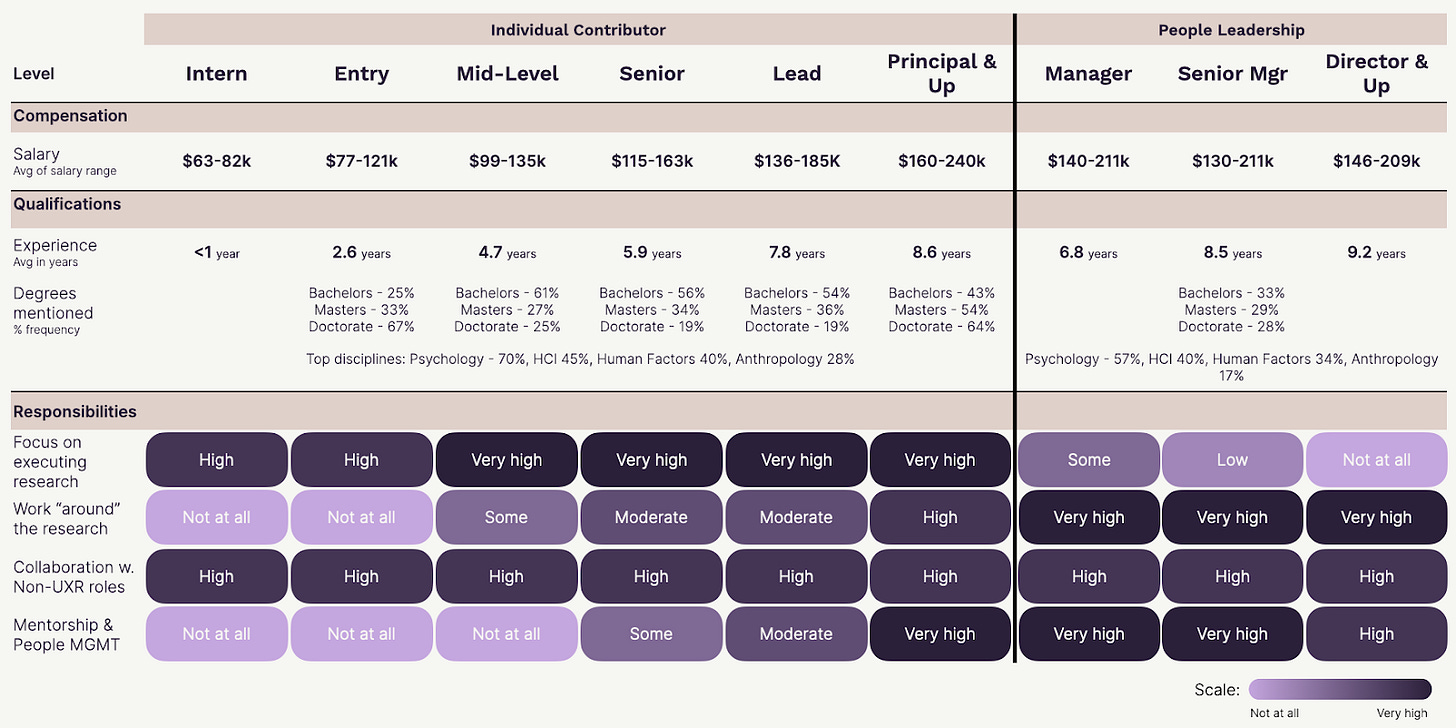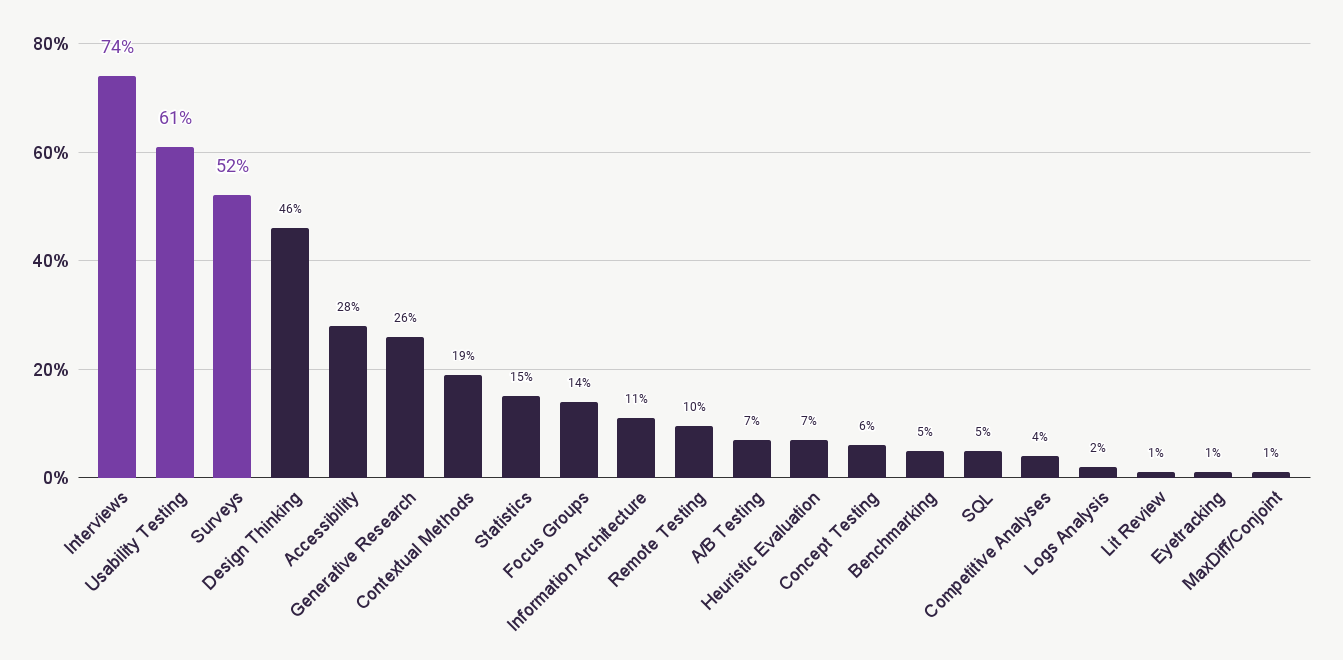How a UX Researcher’s responsibilities change with experience
Building a data-driven UX research career ladder: Part III

As UX Researchers progress in their career, they develop a broader skill set and accumulate diverse experiences through various projects and contexts. But how do these responsibilities evolve from being a junior researcher to a very senior researcher? Are senior researchers simply expected to perform the same tasks with greater proficiency, or are they tasked with entirely new responsibilities?
Understanding how responsibilities change over time is essential for career planning, but with varying titles and limited transparency, getting a clear sense of what to expect has been challenging—until now.
In this series of articles, we have examined 1,396 user research job descriptions to create a data-driven, company-agnostic career ladder (summarized in the figure below). The earlier articles focused on our methodology and the trends observed in job posting metadata, and the qualifications necessary at each level of seniority, including the impact of educational background, degree level, and years of experience.
In this final article, we turn our attention to the responsibilities of a UX Researcher and how they change with increasing levels of seniority. Our analysis divides a UX Researcher’s responsibilities into four key areas: hands-on research work, enabling research, mentorship and/or management, and collaboration with other specialties. The relative focus on these four areas of responsibility defines the differences in seniority levels and helps us understand how our roles change throughout our careers.
Hands-on research is core for ICs, less emphasized for management roles
For individual contributors (ICs) in UX research, the primary focus is, and remains, executing research throughout one’s career.
Hands-on research involves the execution of research through planning, conducting, analyzing, and reporting findings. Our data reveal that from intern to principal level, this core responsibility remains consistent, centered on performing essential research tasks. While proficiency naturally improves with experience, the emphasis on these activities doesn’t significantly change.
The focus on hands-on research remains steady across all levels, but the specific methods used show clear patterns. Across all levels, three core methods—interviews (74%), usability testing (61%), and surveys (52%)—dominate UX research, appearing in over half of all job descriptions. This aligns with other sources of data surveying user research professionals and reinforces how central these techniques are to our field.
Interestingly, as researchers advance in their careers, they use these methods less exclusively, incorporating a wider variety of techniques. For example, interviews are mentioned in 95% of Entry-level job descriptions but drop to 61% at the Principal level and above. This decline indicates that while foundational methods remain important, senior roles demand a broader toolkit. As researchers advance, they incorporate additional techniques (like A/B testing, early concept testing, and discovery research), increasing the diversity of methods used with seniority.

Where IC UXRs remain primarily focused on personally executing research, we see that those in management roles don’t directly contribute as much hands-on research. While some managerial roles fit a “player-coach” model—requiring managers to conduct research—leaders overall engage in research far less frequently. Emphasis on execution tasks drops from 59% in IC roles to 41% for leadership roles. Upon closer inspection, even this reduced involvement often refers to overseeing research rather than directly conducting it.
For example, an IC’s job description might emphasize the importance of conducting, synthesizing, and presenting research. In contrast, a manager’s description focuses more on overseeing research across the organization and translating findings into actionable impact. This shift indicates that leaders prioritize responsibilities that facilitate research rather than conducting it themselves.
Seniority brings greater mentorship responsibilities
Given that management roles are less involved in direct research tasks, what occupies their time? A key area is mentoring and management.
Our analysis of job postings revealed a clear distinction between ICs and management roles regarding the emphasis on mentorship. As one might expect, mentorship is highlighted as a core responsibility for management roles significantly more frequently. But we observed an interesting trend among ICs: at the entry level, mentorship is mentioned in 50% of job descriptions (often referring to receiving rather than providing mentorship). More notably, mentorship expectations steadily increase as ICs reach Lead and Principal levels to 48% and 46% respectively, where mentoring junior researchers becomes a significant part of the role.
This suggests that even outside of a formal management role, senior ICs are expected to develop and guide junior colleagues. Since mentorship is a distinct skill set from technical research, it’s important to set this expectation early, encouraging mid- and senior-level ICs to develop mentoring abilities as they progress in their careers.
Expanding influence through “work around the research”
Another trend for more senior ICs and managers: the focus expands beyond hands-on research execution to what some call the “work around the research.”
These auxiliary tasks support and enhance the research process, making it more effective and impactful. For instance, research operations—such as setting up systems to streamline research activities—and the implementation of democratization programs, which make some research tasks doable for people across the organization, are common examples of this kind of work.
“Work around the research” also entails influencing organizational and product decisions — something we observed that very senior-level ICs at the Principal level and above (48%) are asked to do much more frequently than their mid-level counterparts (18%). For management roles, the expectation to exert influence on the organization is even greater. One UX Research Manager job description, for example, said: “You will support your team in delivering research insights that are high quality and designed to influence decision making for design, product, and business strategy.” In addition to their mentoring roles, management positions focus on overseeing research, ensuring it aligns with broader organizational goals, and translating insights into actionable strategies.
This shift represents an important transition—from conducting research to enabling and guiding it—ensuring that research has a broader impact across the organization.
Collaborations remain important, but change as researchers advance
Collaboration is a fundamental skill in UX research, essential from the start of one’s career and remains important over time. The term ‘collaboration’ appears frequently in job descriptions across all levels, underscoring its role as a core responsibility for researchers. But the question remains: who are you collaborating with?
Our data show that engineers (mentioned in 60% of job descriptions) and designers (57%) are the most frequent collaborators for UX researchers. This makes sense—these roles directly apply research insights to the product development process. Other collaborators, such as product managers (39%), organizational leadership (30%), marketing (26%), and data science (11%), also play significant roles, though the extent of their involvement varies with the seniority of the researcher.
The frequency of collaboration with product managers and organizational leadership rises significantly with seniority. For senior ICs and especially for management positions, these collaborations are pivotal. Managers, in particular, must work closely with both development teams (75%) who build the products, and organizational leaders (71%) who make the strategic decisions that guide those products.

While collaboration is vital for all researchers, the depth and breadth of these collaborations grow as one’s career progresses. Senior ICs engage with a broader range of teams, and management roles collaborate most directly with those who can translate research into actionable outcomes.
The bottom line
How do the responsibilities of UX Researchers evolve as they progress in seniority? How do they change if they choose to take the managerial or IC track? After analyzing nearly 1,400 job descriptions, we identified several key takeaways:
Executing research: For ICs, the core responsibility, regardless of seniority, remains executing research—particularly with the three fundamental methods: interviews, usability testing, and surveys. On the other hand, management roles largely shift away from direct research execution.
Work around the research: As ICs advance in their careers, their responsibilities expand to include tasks that facilitate and empower the research function—what we’ve termed “work around the research”—a shift that’s even more pronounced for management roles. The goal is to evangelize research and increase its influence within the organization.
Mentorship and development: Senior ICs and management roles are also expected to mentor junior researchers. This expands their roles beyond technical expertise into developing leadership skills and supporting the growth of emerging researchers.
Collaboration: Collaboration is essential for all UX researchers, regardless of role. However, as researchers gain seniority, the breadth of those collaborations expands. Managers, in particular, collaborate most frequently with peer leaders across the organization.
These findings offer direction for IC researchers planning their careers. As you progress, expectations include mastering a wide range of research methods and developing the leadership skills necessary to mentor others and influence broader organizational strategies. For managers hiring for their teams, this information can aid in resource planning and ensuring that your team is appropriately staffed to achieve your goals.
The insights from this series of articles—covering salary, titles, years of experience, degrees, and responsibilities—help clarify industry standards and expectations, providing a clearer framework for career development. We encourage both individuals and teams to apply these findings in their work and share feedback with us on their experiences.
From the archives
What does the UX Researcher interview cycle look like after submitting an application, and what are some best practices for candidates and hiring teams? We explored these questions in a series of reports last year.
Improve your collaborations with frameworks for better meetings with your team and stakeholders.










